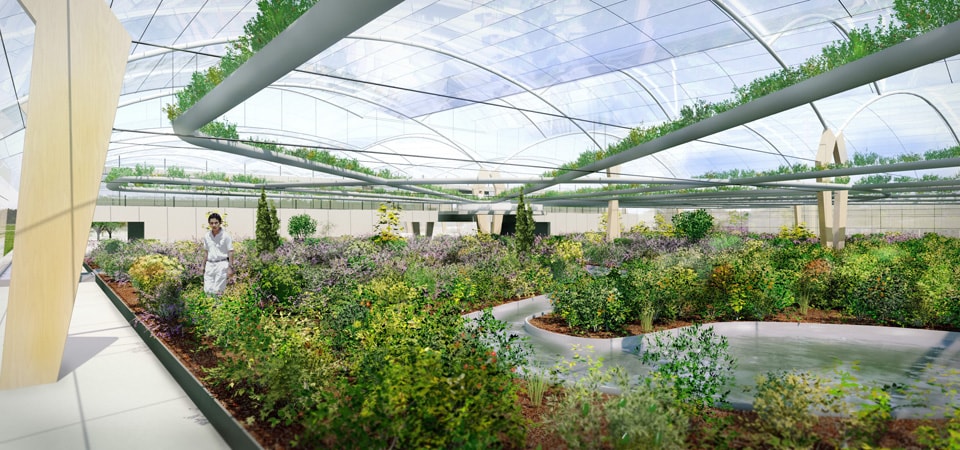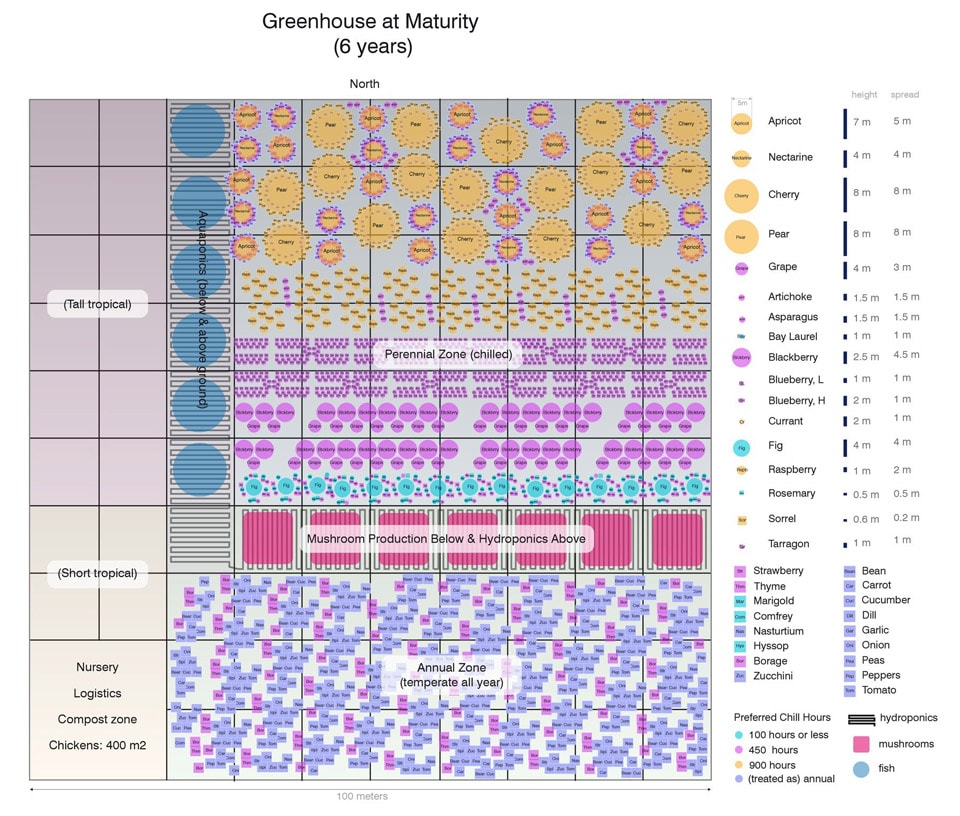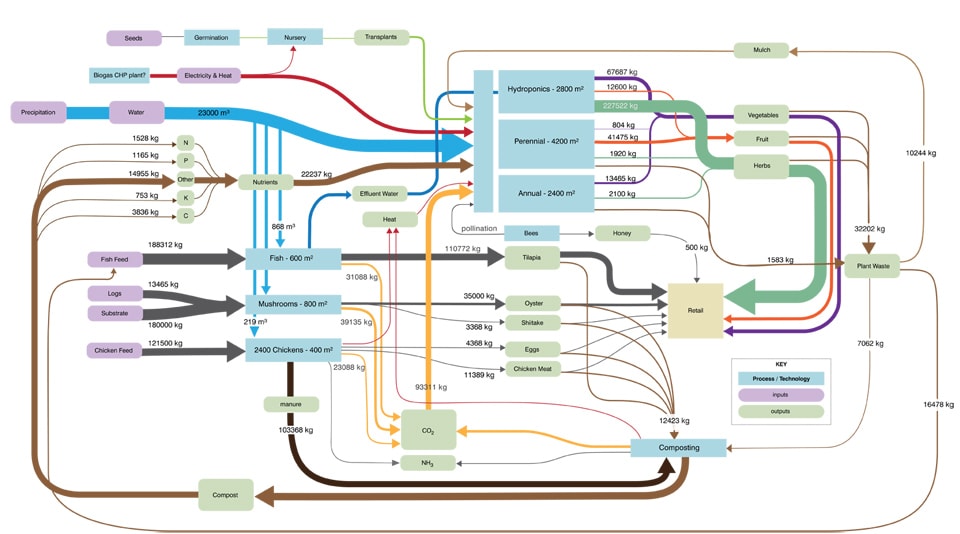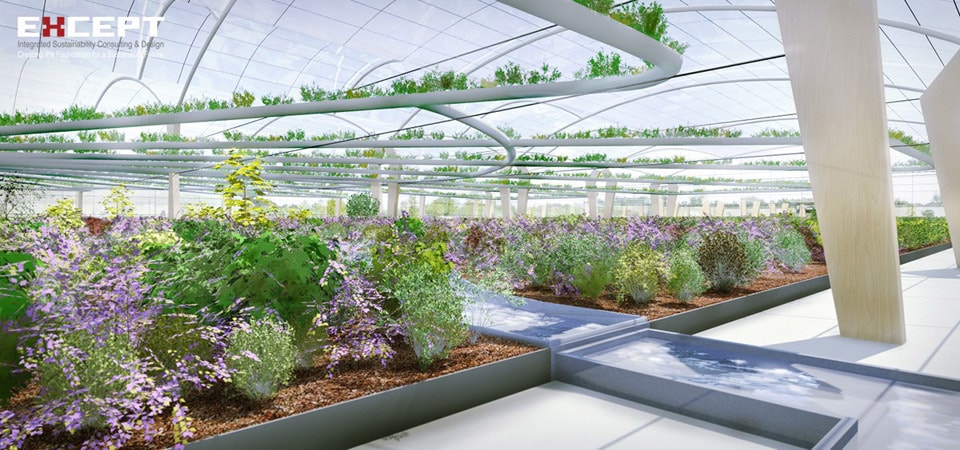In 2009, a group of us at Except Integrated Sustainability began to formulate a vision for a truly sustainable agricultural system. Over the following year, we applied our company’s interdisciplinary, systems-based methodology to develop Polydome, a greenhouse that eliminates agriculture’s negative environmental impacts while producing high yields. It presents a new paradigm for sustainable agricultural production that applies to any context–from dense urban lots to large tracts of agricultural land. Polydome presents new perspectives and approaches for related fields and subjects including agronomy, ecology, economics, sociology, planning and design.
Polydome uses a symbiotic ecosystem of plants, animals, and fungi to maximize food output, eliminate environmental impact, connect biophysical and social flows, and create meaningful jobs. Fundamentally, it shifts agriculture from the current practice of large, isolated monocultures, to distributed, localized polycultures. Such a transformation could reshape the structure of our cities, help localize our economies, and circularize the material flows of our societies. We outline below why and how we developed Polydome, and our vision for seeing it realized in the short term.
At Except, we see sustainability as a property of systems, not objects. True sustainability emerges from the complex interactions within society and how these unfold through space and time.
Why Agriculture?
Human impact now extends across all systems on the planet and agriculture is at the center of this influence. In recent years, the implications of industrial agriculture in particular have been well documented in movies like Food, Inc. and books like The Omnivore’s Dilemma.
All images by Except Integrated Sustainability
Agriculture and livestock are the largest human source of the greenhouse gas emissions that drive climate change, and they are also highly vulnerable to its effects.[1] Livestock production and supply chains cover one third of all land[2] while industrial fishing fleets have depleted or fully exploited over 70% of the world’s fish species.[3] Globally, 1.5 billion people are overweight or obese [4] while 925 million are hungry, [5] and both of these sub-populations are growing. Food both nourishes us and is an underlying factor in many diseases — either through actual consumption [6] or the influenza and drug-resistant MRSA infections bred by high-density livestock facilities. We have increasingly little insight into where our food comes from, and fresh, healthy food is becoming increasingly expensive and sometimes unavailable in daily urban life.
These are all symptoms of our food system’s structural flaws. As a system, it has some pressure points, or “places to intervene” that are more powerful than others. Eating is one of the few things that all humans have in common and is at the heart of our cultures and traditions:
“So many of the social and cultural and psychological challenges we now face—obesity, deteriorating family relationships, lack of connection to something larger—things we now attempt to manage separately and often pharmacologically, intersect at the table. By turning our food over to someone else’s care, we have handed over much of the control of the rest of our lives as well. Conversely, by reclaiming even a piece of the task of food production, by changing food from the passive object it has become to the vital and active enterprise it once represented, we could restore a great measure of balance to our lives.”[7]
Growing and eating food is a metabolic driver for economies, societies, and bodies. While seemingly simple, routine, and inconsequential, choices about agriculture and food dictate our present and determine our future. Rather than continue to attempt to incrementally reduce the harm from industrial agriculture, we have completely rethought the role of agriculture in our food system so that eating can become an ecologically regenerative and socially just act.
Some of the structural problems in the food system can be traced back to our pursuit of efficiency through economies of scale. Industrial agriculture consists of monocultures: huge swaths of single crops or single animal production facilities. While lauded as efficient, monocultures actually perpetuate inefficiency and malfunction by:
- Decreasing the resilience of the system by facilitating the spread of pests and diseases, necessitating chemical control.
- Creating the structural need for complex value chains that siphon money away from farmers and alienate consumers from their food sources.
- Concentrating and separating material flows that would normally cycle between diverse elements in an agroecological system (e.g., animal manure and the plants that require the nitrogen within it).
- Marginalize the farmer in an increasingly complex value chain, and make farming economically fragile.
What is sustainable agriculture?
At Except, we see sustainability as a property of systems, not objects. True sustainability emerges from the complex interactions within society and how these unfold through space and time. A food product cannot be sustainable if it leads to broader patterns of ill health. Nor can it be considered sustainable if it is produced in a way that depletes valuable resources such as high-quality, living soil. This systemic understanding of sustainability is central to the Polydome project, and is at the core of our company’s philosophy and design methodology.
Truly sustainable agriculture addresses multiple issues at once:
- Feeding the world’s growing population in the face of competing land uses and unreliable fresh water supplies,
- Reconnecting consumers with the sources of their food,
- Making farming more profitable for producers, and
- Creating a regenerative system rooted in the beneficial complexity of ecosystems for the cycling of nutrients and the control of pests.
What is Polydome?
Polydome accounts for these issues and envisions how agriculture fits into and drives sustainable societies of the future. Polydome is a design process and a paradigm for creating highly efficient, agricultural ecosystems for greenhouse production that has been followed to create a first example model for a temperate greenhouse. We combined knowledge from permaculture and industrial ecology to create a system that maximizes spatial and temporal efficiency and produces more food output per resource consumed than any existing agricultural system. Our approach creates the possibility of an ecologically regenerative food system that improves local economic and social resilience.
The first Polydome model is a sample design for a 1-hectare greenhouse with over 50 crops, mushrooms, fish, chickens, beneficial insects and support crops. The primary goal was to evaluate the financial feasibility of the approach, evaluate the implications of this system for environmental impact reduction, and investigate what it could mean for social interaction, local economies, and quality of life.
Data, in combination with local contextual factors, drive the Polydome design process. The outputs optimize more than a dozen variables to determine crop selection and arrangement. During the first phase of research for the Polydome project, we developed custom datasets on over 400 crops, fungi, algae, and livestock. We used these to optimize over a dozen variables for determining crop selection and arrangement, its overall system parameters driven by specific local conditions such as supply and demand, culture, spatial constraints, logistics and climate. The Polydome approach offers practical solutions to the problems of industrial agriculture and creates a level of design intelligence that does not currently exist in commercial agriculture.
The Polydome concept is rooted in a flexible systems model rather than any one technology or crop. It accounts for locally available resources and conditions, and can be scaled to any size: from urban rooftops to ground-based, multi-hectare production facilities. It therefore does not have a predetermined shape, typology, or technological system, but it creates those based on the particulars of its local conditions. Polydome is therefore essentially a highly optimized design process, rather than a specific design. The embedded performance criteria ensure that this process results in a highly productive system customized to local conditions and producing negligible environmental impacts.
To facilitate local adaptability, the model includes:
- A wide variety of potential crops that can be customized to cultural and market demands.
- Climate control systems to accommodate any climatic variations efficiently.
- A process for considering social inclusion in decision-making.
- A business case and profitability profile.
In the Polydome system, crops are co-located based on their resource preferences to create the potential for fully connected material and energy cycles: hydroponic production is layered with soil-based crop production, internal logistics systems simplify harvest and processing, and biophysical flows between different elements are beneficially coupled. While advanced greenhouse technology supports the system, it is not essential to it and Polydome systems can be customized for low-tech scenarios.
Spatial layout of greenhouse crops for one hectare plot
Polydome also creates a new financial and labor structure for agriculture by cultivating a polyculture system instead of a single crop. A Polydome greenhouse produces a variety of high-value products that can capture a large portion of a product’s value chain through direct or local sales rather than growing a single product for low-margin wholesale through national distributors. Polydome can be coupled with social programs and neighborhood resource cycles such as water, waste, and employment. When producers sell directly to customers, they earn more money while diversifying the types of labor that they perform. The high variety and productivity of even a small Polydome can provide a healthy food supply for a large population, making it particularly applicable in urban contexts.
Distributed, diverse, and locally appropriate human systems are key trends in sustainable development. This shift increases societal resilience and encourages a more equal distribution of power, resources, knowledge and financial gains. The Polydome approach improves food access and quality, local biodiversity, and neighborhood resilience. It adds new layers of financial feasibility, physical scalability, and data driven management to this movement and uses polycultures as a key strategy for economic, ecological, and social value creation. The result is a cornerstone of a new landscape that can revitalize depressed areas, assure long-lasting sustainable redevelopment, and serve as a catalyst for social change and urban renewal.
Development Process
Polydome is the product of a diverse team representing over a dozen disciplines and four nationalities. The team drew on a variety of competencies and knowledge sets including agronomy, architecture, community and economic development, environmental engineering, graphic design, industrial ecology, and permaculture.
The report focuses on process and system integration over built form and represents one iteration amongst the many possibilities. It is available from our website for free under a Creative Commons license. The primary goals of this iteration were to evaluate the financial feasibility of the approach, look at the implications of this system for environmental impact reduction, and investigate what it could mean for social interaction, local economies, and quality of life.
Tools
Industrial Ecology is a field with tools for strategically mapping the material inputs and outputs of a system across its entire life cycle. The field seeks the optimization of these flows and has recently begun to include social considerations. We used an industrial ecology approach in quantifying the changes in the approximate material profiles of the model systems in terms of energy, material, water, waste, crop yield, labor, and other flows.
The word permaculture is a contraction of the words “permanent” and “agriculture.” It is a design philosophy developed in Australia in the 1970s, which has since gained popularity worldwide, but has generally been limited in its influence to rural contexts and field farming. The goal of permaculture is to establish long-term, self-regulating human systems that are largely modeled after natural ecosystems. Permaculture focuses primarily on agricultural design, though recent work has focused on extending its reach.
The permaculture approach contains twelve design principles which include: relying on diversity, transforming linear flows into cycles, and ensuring that each element within a system provides multiple beneficial functions. These principles were incorporated in our goal-setting process.
Our primary concern in this design was to create a functional ecosystem through the careful selection of crops and livestock. We used our in-house systems-thinking methodology, Symbiosis in Development (SiD) as a framework for combining these two sets of tools. The five steps in any SiD analysis involve:
- Goal setting: Establishing the performance criteria of the final design in regards to the primary SiD categories: energy and materials, ecosystems and species, culture and economy, and health and happiness.
- Mapping the system: Identifying the key elements that make up the system of interest and defining their connections. In this process, system mapping consisted of two key parts: defining system boundaries (e.g. what crop and livestock elements are we going to include, and why?) and then examining key relationships and flows.
- Synthesizing knowledge: Combining all the data from the system mapping exercises, gaining an overview of key leverage points.
- Optimizing the system: Positioning key elements in the most beneficial way relative to one another and scaling them appropriately. Considering effects in time, space, and context.
- Evaluating and iterating: checking our results against the goals we set out in the beginning, and returning to earlier steps as necessary. We are now in iteration processes for two potential sites.
Before designing the ecosystem, we identified and synthesized the many existing strategies for holistic, ecological agriculture. The project began with three months of interviews with horticultural experts and commercial growers and continued into a data gathering and modeling phase using SiD. In the phase prior to the SiD analysis, we also began assembling the required data: a large library on crop, livestock, mushroom, aquaculture production, and sales.
Ecosystem design method
In a natural ecosystem, plants and animals arrange themselves through a continuous process of trial and error. Living creatures are constantly traveling, reproducing, and dying out and a population’s pattern of distribution adjusts to changing conditions. Natural ecosystems are constantly in flux, facing climatic fluctuations, physical habitat changes, and varying concentrations of food availability. During periods of relative stability, species settle in patterns that take advantage of the current conditions.
For example, along any rocky coastline, plants and animals arrange themselves in bands dependent on factors such as the other species present and the distance from the water. Areas that remain under water even at low tide harbor the most water-dependent species, such as fish and anemones. As we move towards the shore, to areas that may dry out towards the end of the low tide period, we start finding species that are slightly less water-dependent and more mobile, such as sea stars, crabs, and snails. Even further towards the shore, we start to see areas densely packed with organisms that can seal themselves off from the dry air, giving themselves several safe hours of life without water, such as mussels and barnacles. This kind of stratification is based on the needs and survival capacities of each individual species.
Over time, organisms evolve together in shared ecosystems and create mutually beneficial relationships. Through these kinds of evolutionary pathways, all organisms have their specific patterns of interaction with others. Some are straightforward relations, such as the cycling of basic nutrients, while others are more complex, involving intricate defense, growth optimization and other symbiotic patterns. Frequently overlooked organisms such as fungi and bacteria can function as system supports or catalysts. Organic systems are more effective than any technological device and most of these organisms simultaneously serve multiple functions such as energy capture, defense, storage, production, and conversion. The organic symbiosis in the Polydome system increases output, resilience, and flexibility without involving any artificial technologies or inputs.
Our task in designing the Polydome ecosystem was to recreate the phenomenon seen in living ecosystems: an optimized species combination and spatial distribution for each species in the system. Our need to go beyond biological optimization and incorporate social and economic goals complicated the assignment. We also wanted to arrange species based on their maintenance frequency, economic productivity, and, in the case of animals, strong ethical considerations for their health and natural behavior.
Conducting such an optimization on paper, without an experimental space where we could place animals and plants next to each other, required collecting large quantities of data. First we had to determine which exact data points were critical for our work. These included information for individual species as well as their potential relationships such as light, soil pH, soil oxygen, moisture, nutrient levels, temperature hardiness, and chilling requirements. After determining the full range of necessary data points, we created a data filtering and optimization process. The Polydome model systematically filters a very large amount of information about crops and livestock, and optimizes it for over a dozen variables. Ultimately, the most important outcome of the initial phase was the design of a functional, replicable process for assembling a polyculture system rather than perfecting a single design.
We used the SiD method to develop Polydome as a tangible example of the potential to embrace and use the strength of complex systems to resolve societal issues. Highly effective solutions arise when design focuses on society as a system of interconnected relationships rather than individual “things.” The same method can be applied to other systems, such as cities and organizations. SiD maps whole systems and results in solutions as diverse as urban redevelopment plans, knowledge management systems and new business models for organizational innovation. The resulting symbiotic processes drive healthy, profitable, truly sustainable and feasible solutions.
Spatial design paradigm
Polydome’s approach offers many new perspectives on spatial design strategies. The systemic approach to solution development and urban landscape reformulation are the most important to focus on.
Polydome carries the seeds and the social connectivity to resolve many of the urban issues we face today. Polydome does not dictate a shape, form, or technology, and remains effective at much smaller scales than conventional agriculture. Therefore, designers can embed it in many existing environments and contexts as a central metabolic engine for area redevelopment. By finding the disconnected social connections of a given location, as may be present with elderly, young, unemployed and socially fragile individuals, and involving them within the system, Polydome could be a vital engine for social reform by involving marginalized populations in the system.
Polydome has substantial implications for architecture and landscape design. The green revolution relegated agriculture to the fringe of these disciplines. Polydome places food production at the center of design and harnesses its connection with everything we truly care about in our society. Its flexibility and independence from technological devices make it suitable for most cultures, locations and conditions. Polydome is an open-source project and we hope that this makes its solutions available to everyone in a time frame that can create meaningful change.
Next Steps
Our goal for the first Polydome is to evaluate the details of the system in practice. All of the individual technologies and crop combinations in the model are proven, and the next stage of research is to optimize the system based on an operating facility in context.
This year, we are working to site and build the first operational Polydome. We will explore partnering with Wageningen UR University & Research Centre and Innovation Network to create a Polydome system in an existing greenhouse facility in order to refine our model, test our ideas, and use it as a demonstration ground for attracting further capital and interested entrepreneurs. We are also currently putting the finishing touches on a new rooftop Polydome model for a site in Rotterdam and partnering with the New Haven Economic Development Corporation to develop a site in Connecticut.
Conclusion
Polydome presents a new type of biological, economic, and physical system for growing food. It offers a paradigm shift and addresses powerful places to intervene in the food system: from monoculture to polyculture, from linear to cyclical flows, from destructive to regenerative, from socially disconnected to engaging. These shifts must occur in order to create a truly sustainable food system, whether it takes the specific form of the existing Polydome model, or a future variation thereof. The system is based on long-term, perennial crops, ideally housed in lasting structures, that are embedded in the cultural landscape and provide value beyond the food produced, including the regeneration of rural and urban landscapes. As Polydome takes specific forms in the built environment to suit different local conditions, the project will create a new level of design intelligence through iterative and close collaboration between architects, planners, designers, and scientists.
We believe strongly in transforming the urban landscape through design processes that are rooted in systems-understanding and data, adaptable to local conditions, and judged using clearly defined performance criteria. It is both possible and imperative to design beautiful, complex creations that account for the constraints of our global system. By harnessing this knowledge, design can reshape our world more powerfully, whether it is in agriculture, products, or the built environment.
Polydome presents a design paradigm that can feed us well and contribute to the long-term resilience and health of our world. It offers one solution amongst the many other massive changes that are required to make the food system work for everybody, all the time.
We invite everyone to view the video and download the full Polydome report. Polydome is in the Buckminster Fuller Challenge and the St. Andrews Prize for the Environment for 2012. You can comment on our Buckminster Fuller entry in their Idea Index.
 Ariana Bain is an industrial and urban ecologist in the New Haven Except office. She thrives on finding tangible and quantifiable ways to synthesize and communicate seemingly disparate ideas like “industrial” and “ecology.” Some of her other projects have tracked scrap dealers through India, followed coffee beans in the Nicaraguan campo, started the first university-level sustainability education program in Bangladesh, and created strategic plans for US corporations.
Ariana Bain is an industrial and urban ecologist in the New Haven Except office. She thrives on finding tangible and quantifiable ways to synthesize and communicate seemingly disparate ideas like “industrial” and “ecology.” Some of her other projects have tracked scrap dealers through India, followed coffee beans in the Nicaraguan campo, started the first university-level sustainability education program in Bangladesh, and created strategic plans for US corporations.
Ariana is a Senior Fellow in the Environmental Leadership Program and holds a MESc in Industrial Ecology from Yale University and a BA in Political Science and Environmental Studies from Wesleyan University. She has coauthored two recent academic journal articles: Assessing the “short mental distance” in eco-industrial networks, and Industrial symbiosis and waste recovery in an Indian industrial area. Her work on industrial symbiosis, social networks, and social capital was presented at the 2011 International Society of Industrial Ecology conference. Over the past seven years, she has worked as a consultant, an academic, and a farmer.
 Eva Gladek, a native of New York City, is an industrial ecologist passionate about sustainability. Eva integrates knowledge from across the natural and social sciences to develop innovative solutions in sectors as diverse as agriculture, electronics and information management.
Eva Gladek, a native of New York City, is an industrial ecologist passionate about sustainability. Eva integrates knowledge from across the natural and social sciences to develop innovative solutions in sectors as diverse as agriculture, electronics and information management.
Eva began her scientific career as a molecular biologist, and continued on to work as a science journalist and television producer before developing her expertise in industrial ecology. She is an expert in technical environmental management techniques such as Life Cycle Assessment, Material Flow Analysis, and applying green design principles. Some of her recent projects include the conceptual development of Polydome, a high-yield greenhouse that functions like a natural ecosystem and offers the potential for net-zero-impact food production. She also recently worked on optimizing the material flows in a social housing neighborhood in Rotterdam, developing guidelines for the production of greener chemicals for a large chemical manufacturer, and designing a financing platform for sustainable development. Eva holds a Master in Industrial Environmental Management from Yale University and a Bachelor in Molecular Biology from Amherst College. Since 2009, she has served as Technical Director of Except Integrated Sustainability.





